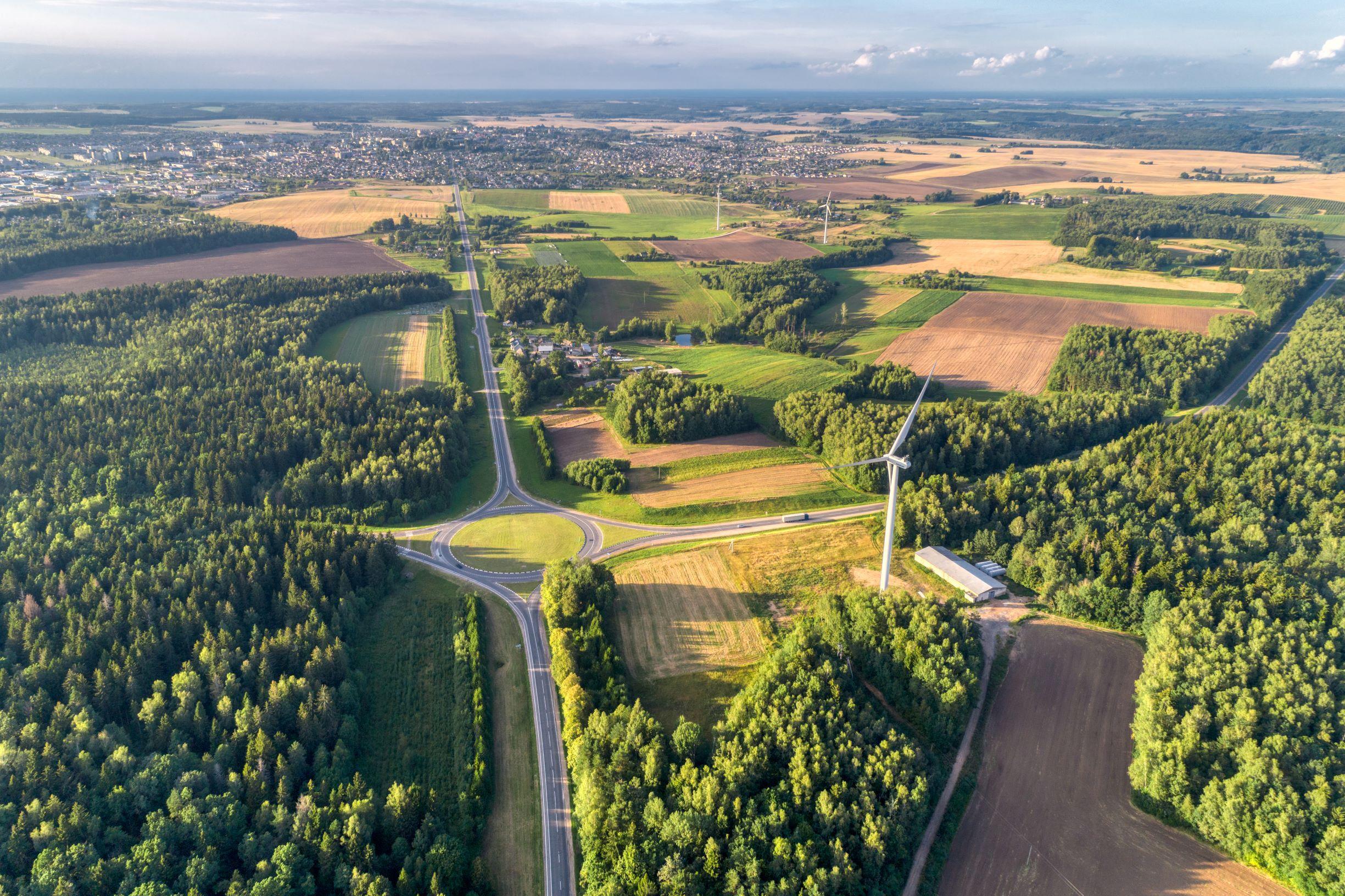

The UK has a high-quality transport system. It’s not perfect; there are gaps, areas for improvement or replacing, and it sometimes struggles to meet our needs. However, it connects people, goods and places, it’s flexible and resilient and is a backbone to our economy and society.
Yet our transport system is still responsible for 34% of GHG emissions, arising from road transport, domestic aviation, railways and domestic shipping and is shaped by and has evolved to serve a carbon-based economy.
As a society, we now realise – perhaps belatedly – that to eliminate carbon and get anywhere close to Net Zero by 2050, we must rapidly transform this system to play its part in a Net Zero carbon economy, and this presents some pressing challenges.
This means making a significant impact in the 2020s. If we don’t, then, as per the Climate Change Committee’s Sixth Carbon Budget,1 we will by 2030 already have used our carbon budget through to 2050. To stay on track with the pathway to Net Zero, the transport sector needs to reduce emissions from transport by around 50% in only 10 years.
The most significant component on the pathway to 2050 is the shift from internal combustion engine road vehicles to electric vehicles powered mainly by electricity from renewables. But even accelerating the supply and take-up of electric vehicles and expanding our charging infrastructure to the 400,000 chargepoints as estimated in the ‘Charging Up’ report 2 won’t be enough. It is still unlikely we can achieve the level of decarbonisation needed by 2030 without also doing something else.
First, we must recognise that much of the infrastructure we have now will still be there in 2050 – so maintaining and transitioning the use of this legacy infrastructure to low or zero-carbon is clearly critical for Net Zero.
The UK will also be investing significant sums of money in new transport infrastructure projects that are in development now or planned as part of broader programmes to meet the future needs of our society and our economy. The CCC estimates that delivering Net Zero will require approximately £50 billion each year by 2050, across all sectors. While the recently announced UK Green Infrastructure Bank is expected to have around £12bn of funding, this will merely touch the surface of the overall need.
Investment in new transport infrastructure projects broadly falls into two categories. Those that provide entirely new connectivity and capacity, such as HS2 or a Lower Thames Crossing and those that are effectively upgrading or reconfiguring our existing infrastructure, such as digital roads or urban sustainable transport schemes. In most instances, big projects are a mixture of both; reconstructing existing infrastructure even though it is not yet life expired to make it work harder and adding new components.
Across the transport industry, we need to think about how new transport infrastructure projects will help achieve Net Zero – and specifically, deliver significant decarbonisation by 2030, and how we will fund the projects that will positively impact people’s lives.
Major public transport schemes clearly have the potential to shift large volumes of travel on to low carbon modes. It can take 20 or so years to move such strategic transport infrastructure schemes from conception through to operation. Similar rules apply, even for large local major projects typically sponsored by local authorities.
Realistically, any big public transport projects conceived or in development now would be unlikely to deliver decarbonisation benefits until at least the late 2020s, so they won’t be helping reduce carbon in the critical period to 2030.
Highway projects are more difficult. Until there is a predominantly electrified car, van, and heavy goods vehicle fleet, the projects won’t be contributing to Net Zero even if they are operational before 2030. That’s not to say that we shouldn’t progress or develop new schemes providing carbon can be minimised through design and construction, and we plan to eliminate future operational carbon emissions. However, it’s important to be aware that these projects won’t be delivering decarbonisation in the 2020s.
Transport needs a large tranche of quick solutions to implement, high decarbonisation impact projects, which will rapidly start to reduce travel by the most carbon-intensive modes. In this way we can help achieve the 17% reductions in travel behaviour shifting from car to other modes as identified in the 6th Carbon Budget as a critical component of the pathway.
These projects should enable a rapid move to electrified public transport, smaller personal vehicles, and active modes, focussing on urban areas where the potential for shifting large volumes of travel onto low or zero carbon modes is high. It means electrified local public transport, high-quality active travel provision, micro-mobility schemes and shared-transport provision. It also means bolder moves to prioritise road space to high-capacity zero-carbon modes to maximise mobility and support decarbonisation. This is not easy, but these are all within our grasp and, if we move quickly, deliverable in the 2020s.
It is worth taking a comparative look at the energy sector. Even with the great strides taken to reduce emissions, the energy sector must replace almost all the current ageing generating capacity and build as much again to decarbonise as well as power our future electrification demand. According to a report 3 from the energy business in Atkins, this is an estimated build rate of 9-12 GW every year, for 29 years, across firm power (natural gas, nuclear and biomass) and intermittent sources (offshore, onshore wind and solar). In practical terms, this looks like 48 gas units, six nuclear power stations, 66 biomass, 6250 wind turbines offshore, and four times the world’s current capacity for carbon capture and storage (CCS).
What is the transport equivalent? We know that over 50% of our railway still needs to be electrified. According to a recent working paper 4 from The International Council on Clean Transportation (ICCT) we will need 45,000 charging points in London by 2035.
If we can electrify fully, then the same imperatives to improve connectivity and capacity that have underpinned new infrastructure to date will most likely remain, though with greater weight on environmental issues and increased energy demand. If we can’t, then we could have to rethink our programmes.
The transport sector also doesn’t really know how travel demand will change, how business, work, leisure, housing, retail, food production and so on will adapt to a Net Zero economy. The signals suggest that there is a risk of people reverting to old habits. According to a report from the Centre for Cities 5, 80% of cities saw a return to pre-pandemic air pollution levels when restrictions eased.
So, transport needs new, quick, high-impact projects to reduce carbon from transport in the 2020s. Right now – most probably in urban areas – we need projects to complement the accelerating shift towards an electric fleet, and to reinforce behavioural changes in our travel and reduce carbon emissions.
Yes, we need to continue to progress new, big transport infrastructure projects, but we can’t expect them to contribute to reducing carbon in the crucial period up to 2030. However, the transport industry must plan and design them to minimise carbon in their construction and operation and ensure the necessary investment is made to align them to the different needs of a Net Zero economy quickly.
Tony Meehan is practice director at transport consultancy Atkins
1 Sixth Carbon Budget https://tinyurl.com/v9dz4e9u
2 Charging Up https://tinyurl.com/8fndmvx3
3 Engineering Net Zero https://tinyurl.com/y5dy5dzk
4 Fulfilling electric vehicle charging infrastructure needs in Greater London and its boroughs https://tinyurl.com/93a8zjzw
5 How have the Covid pandemic and lockdown affected air quality in cities? https://tinyurl.com/2ew8nxb4

TransportXtra is part of Landor LINKS
© 2025 TransportXtra | Landor LINKS Ltd | All Rights Reserved
Subscriptions, Magazines & Online Access Enquires
[Frequently Asked Questions]
Email: subs.ltt@landor.co.uk | Tel: +44 (0) 20 7091 7959
Shop & Accounts Enquires
Email: accounts@landor.co.uk | Tel: +44 (0) 20 7091 7855
Advertising Sales & Recruitment Enquires
Email: daniel@landor.co.uk | Tel: +44 (0) 20 7091 7861
Events & Conference Enquires
Email: conferences@landor.co.uk | Tel: +44 (0) 20 7091 7865
Press Releases & Editorial Enquires
Email: info@transportxtra.com | Tel: +44 (0) 20 7091 7875
Privacy Policy | Terms and Conditions | Advertise
Web design london by Brainiac Media 2020